james thompson
Active Member
What do you think would be a good ground substance for a breeding pair of orange bearded dragons?:?

Calcarosols- These soils contain calcium carbonate (as limestone, calcrete ***or other forms) as soft or hard fragments or as a solid layer. They occur in areas with low rainfall. Limitations for agriculture include shallow depth, low water retention and wind erosion. this type of soil is prominantly in the area of lower south australia on the rims or outskirts of central bearded dragon habitat, although some still live there it still explains a similar soil to the of central Australia with hard fragments and top soil and tow water retention leaving a hard packed soil.
*** Calcrete is a chemical balance or configuration that makes the soil go hard, it is when calcium and also magnesium disolve in water when the water evaporates they form small crystals and these crystals can keep growing when more carbonates (chemicals like calcium and magnesium) gather in the area along with water. this hardens the soil, giving it the name cal-crete (cal for the calcium and other carbonates) and (crete relating to the strength of concret) these carbonates are found naturally in the soil, especially when the soil is high in clacium carbonate. this soil is similar to the dangerous product 'calci-sand' it has the same effect, the calci sand will even harden and become calcrete inside your dragon digestive tract, this can cause problems like impaction which can lead to death. this is why it is dangerous to use calci-sand as a substrate.
I do agree, somewhat, with the statement that alot of the responses are opinions. However, for us experienced people no, they are not our opinions. They are tried & true methods, ones that have worked for years & are in the best interest of the dragons. We could say the same thing about old outdated books also! They are just the writers' opinions, or, are they facts, based on what they know to be true that have worked for years?
It is a great idea to do research, & then compare to make sure you come up with the most solid answer possible.
I would like to make a comment about sand, just in general, if I may do so.
One reason I am not a huge advocate of sand, or loose particulate, is not just because of impaction but because of sanitary reasons. Alot of people have busy lives & tend not to clean out tanks like they should be cleaned out. When they live in a tank, not outside, they have to "live" in their toilet. Outside, they go potty, & then, "live" somewhere else. I can just about guarantee that they don't come across it again that day. They may choose a general area where they go, like your dog might have marked his toilet area in your backyard, in that manner. They have less chance of picking up a parasite or worm outside than they do in a dirty tank. Especially if you feed inside a tank with sand, they could ingest eggs every time. Really, if you aren't careful, they will end up with more than an impaction. You have to think about, would I want to live this way, & do I want my dragon to live in that manner? I feel it is just common sense.
Now on the other hand, it you are emmaculate with your cleaning, & scoop religiously, then, the only type of sand that is relatively safe is washed & sifted playsand.
I want to elaborate on everyone's definition of causes of impaction. The intestines contain thousands of microvilli which basically work to help increase the surface area of the intestines to help them absorb the nutrients more efficiently. When sand or other foreign materials begin to build up in the intestines, whether it be a baby with a sharply curved intestine, or an adult with a straighter intestine, it really doesn't matter. They will still suffer the same problems of malnutrition, over time, because it gradually settles in the lining, which disrupts the absorption of food & nutrients & affects & destroys the microvillis ability to work effectively. That in turn can cause other imbalances in the chemicals in their system to become out of whack such as electrolytes, calcium, etc. So you not only have a built up impaction that may or may not pass, but you have an ongoing health problem due to lack of nutrition.
Sorry I hope you don't mind me adding that. Alot of people don't understand fully the effects of what an impaction can & will do to an animal, just in general.
I feel all of our goals should be the same here, to learn, to educate & to help as much as possible to those who are willing to apply the knowledge.
Tracie
the central bearded dragons natural soils is extremely varried, it is true some areas such as the south east segment of 'territory' that there are natural landmarks named 'travelling sands' which in truth are large sand-dunes stretching for miles. But, this isnt to say that these animals live on these dunes without shade vegetation, food or water, in all seriousness, why would they? the large blue area on the image below isnt to say that in every square meter or area shade blue belongs a wild central bearded dragon thriving in his naturalistic environment, the truth is they can and do move around especially after hatching, to find a solitary and thriving environment, free from fellow siblings, preditors and even other species of dragon, and of course, a sutable substrate for future burrows and egg laying.
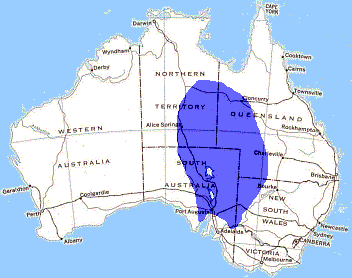
as i said before, the soil scape of the australian outback is extremely varied, from hard rock, cracked clay, hard packed soils, to compact dunes, and bushland soils. patches of soil become more 'dirt' or darker soils, as the tree's and foliage die. other areas become stripped with rain, leaving hard rock and clay, left to 'bake' as the weather warms. some areas, for instance Uluru, or the Olgas or Mt Connor are proof that terrential rains in the wet season, and the fact this place used to be underwater and a big ocean. that the landscape is practically 'stipped' of loose soils. its just a big rock.. lol
here are some images of the soil types etc. of their natural environment.
this image is of the hard packed cracking clay of the simpson desert.
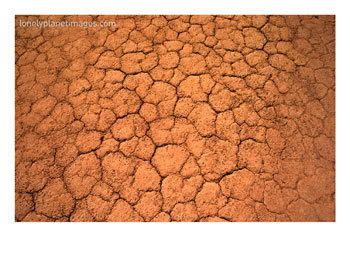
heres another of simpson desert
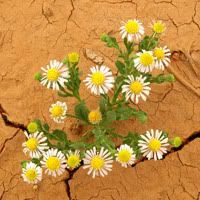
Mt Sonder

Mt gillen
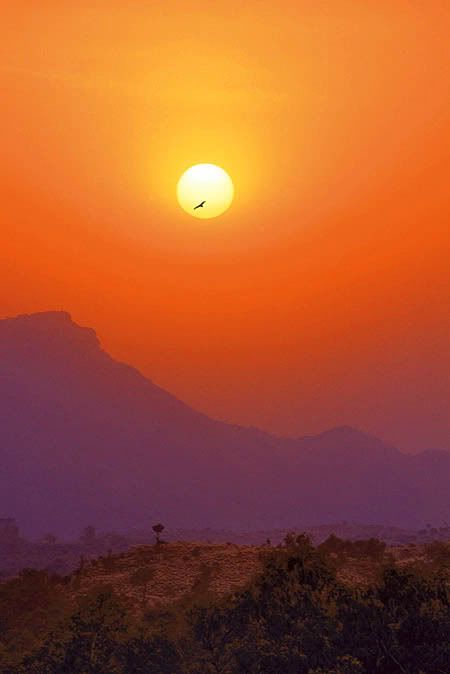
Mt Conner
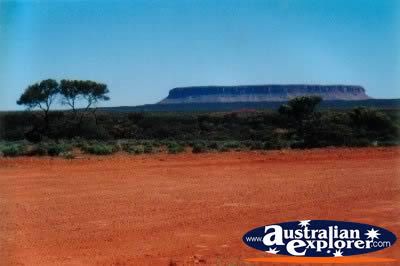




Western Bearded Dragon

Central Bearded Dragon
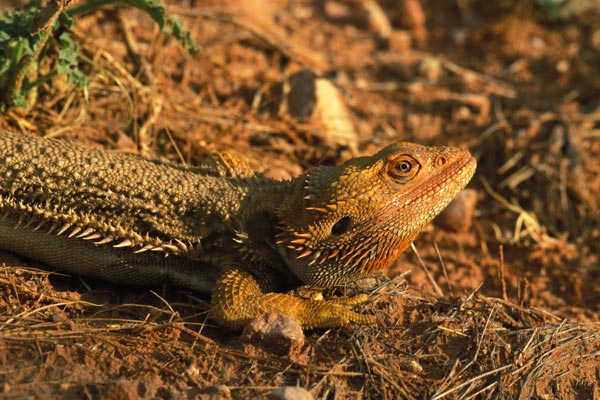
Central Bearded Dragon i love this one, its ADORABLE

Central Bearded Dragon
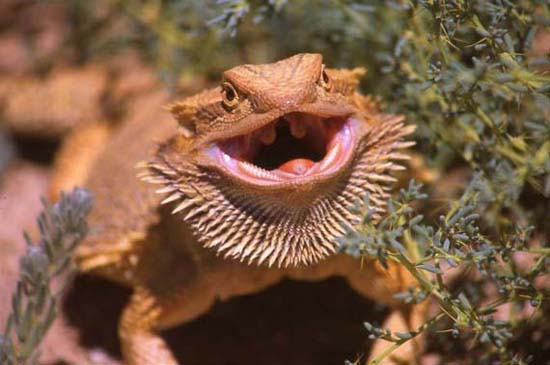
as you can see, there isnt much soft or particle soils. there is some dusty red soil areas, and alot of hard packed, and rocky planes.
their natural soils, are in fact not entirely safe. as mother nature goes, and the deaths of pretory feasts, impactions by soil, food and other foreign objects come, their population seems to level out, even with tens of thousands dying on our roads each year. they seem to be a 'feeder' food themselves by other reptiles, and preditory birds and wild dogs. there soils can contain chokable and impacting rocks, calcium based sands (in clay mixes) and even twigs and bush litter. keep in mind alot of wild animlas die of impaction, there not someones pet, there not expected to be looked after, as they are 'mother natures responsibility' and in this a natural death and cycle.
in no way should you put your dragon at risk (imo) in a captive environment, via preditors, or dangerous substrates or impacting articles (stones twigs). it is our responsibilty as their care givers, to provide a safe and loving environment, free from dangers and health risks. this includes a purely naturalistic substrate.
i choose slate or ceramic tiles, textured and glased, as well as siliconed inplace for extra ease with cleaning. from my visits to the central australia desert, and the research ive made with the chemical makeups and government statistics on the deserts soils. i feel this is the most natural, easiest and safest for my dragons. (i havent even touched on the governments chemical classification of soils, to back up the images or statementsthis will be a few more pages long
)
Sand, IMO, doesnt even allow digging, they may shift and throw around the loose soil. but they do not successfully make a burrow or den as they would digg for in the wild to escape heat of day, and lay eggs... sand isnt 'prefered' by many species of reptile and marsupial as it doesnt allow sufficient grip, or a balance for quick get-aways. it doesnt flourish the bushland for hiding, shade or food, and doesnt allow water to hold in the soils or in pools. thicker, harder, less particled soils or harder in chemical makeup allow growth and 'life'. clay is found in most soils all across australia. in fact its in my own back yard.
'particle susbtrates' each to their own are undoubtably 'foreign undigestible material.' this to me, does not make it safe, or suitable. i use ceramic tiles, and repti-carpet. both being non particle and safe. each to their own having added benefits, or soft and snuggly, and keeping nails trim, and easy to clean. with tile being naturalistic. and both with a aesthetic appeal.
as for no 'safe' substrates allowing a 'burrow', i find a suitable, snugg hide will do the trick, after all they only want a 'snug' spot to feel secure. either soft towels, orplane straight on the indoor/outdoor carpet, puppy enjoys best.
Enter your email address to join: